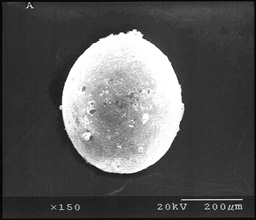
Every day the Earth is bombarded by literally millions of meteors per day (some estimate as many as 25 million). Only a very few of these are large enough to survive the intense heat of entry into our atmosphere (maybe a few hundred per year). The remainder (usually between the size of a grain of sand and a pea) are evaporated.
But if you stop and think about it, much like water will condense back into a liquid form after evaporation, so too will the evaporated iron (and other metals) which make up the meterorites condense after cooling. In solid form, these "micrometeorites" then fall to Earth.

This is an image of one of these micrometerorites which was found in the parking lot next to Dr. Mike Briley's office in Halsey Science Center at U-Wisconsin Oshkosh (from whom I am shamelessly "borrowing" this picture and information!). It's actual size is much smaller (barely visible to the naked eye) and it has been blown up 150 times by an electron microscope.
These objects are everywhere! If you want to find some for yourself, all you need is a magnet, a little plastic bag, and a low-power disecting microscope.